The Best Way to Store Asparagus (I Tested 7 Methods!)
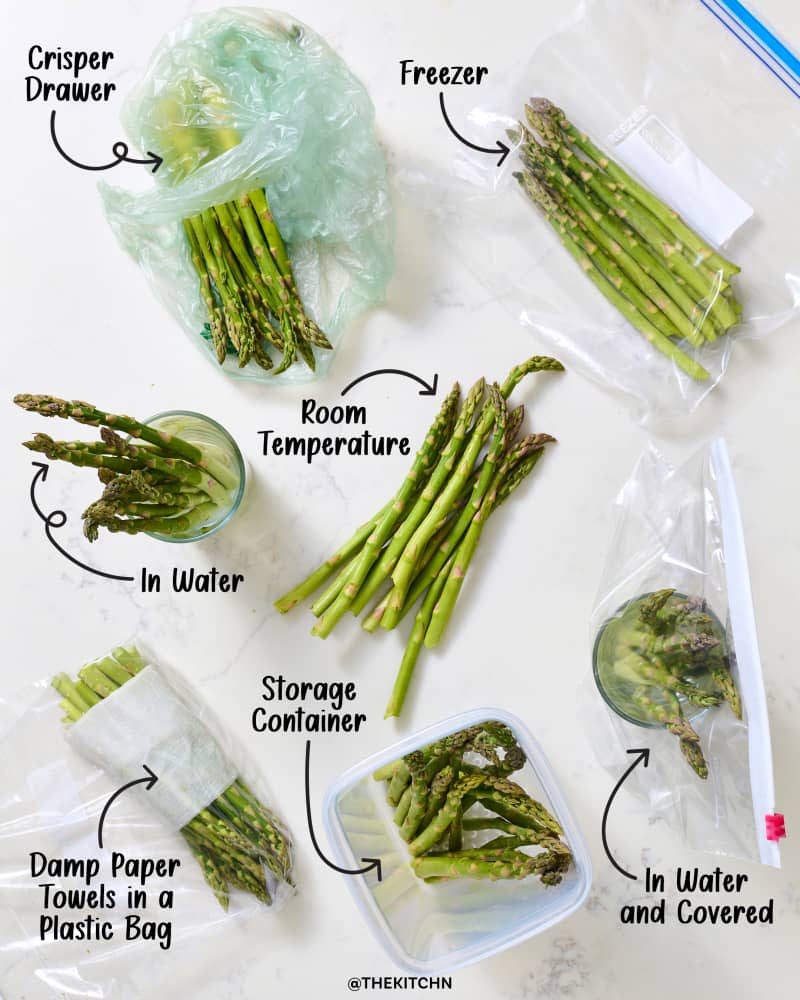
Table of Contents
By the time spring rolls around, we’re all ready to move away from the hearty, earthy root vegetables of cold-weather eating and fully embrace the tender green things the new season has to offer. There is no better example of this than asparagus. With its crisp-tender bite and subtle grassy-nutty flavor, it’s a lovely addition to risotto or as a quick and easy roasted side to a grilled chicken breast.
Because its season is fleeting, we may go overboard on the asparagus (I know I’m not the only one!), snatching up more than we can quickly consume when we find it at the farmers market or grocery store. Even when it’s on sale, it’s not exactly the least expensive produce you can buy, so you definitely don’t want it to go bad before you can get a chance to enjoy it. To discover the best ways to store these tender stalks so they last longer, we found seven different storage methods to test against each other. Read on to see which ones worked best.
One method stood out as the real winner: Wrapping the stalks in damp paper towels and sealing it in a zip-top plastic bag. It yielded pristine, perfect asparagus after two whole weeks.
A Few Notes on Methodology
The asparagus: I purchased the freshest asparagus I could find, buying it all at Costco. All of it had the same pack date (which was six days prior to my purchase). I kept all of the asparagus unwashed and untrimmed, and used a one-pound bunch for each method.
The testing: I stored the asparagus for as long as the method could handle, stopping the test just before any asparagus got too slimy or withered to cook and eat. I stopped all testing at two weeks (because I had a deadline to meet). After a thorough visual inspection, I trimmed the asparagus and tasted it raw, and then lightly steamed it to see how it was when cooked.
Ratings: I judged each method on a scale of 1 to 10, with 10 representing perfection. The criteria that went into my ratings included texture, flavor, and general ease or difficulty (or expense) of the method.
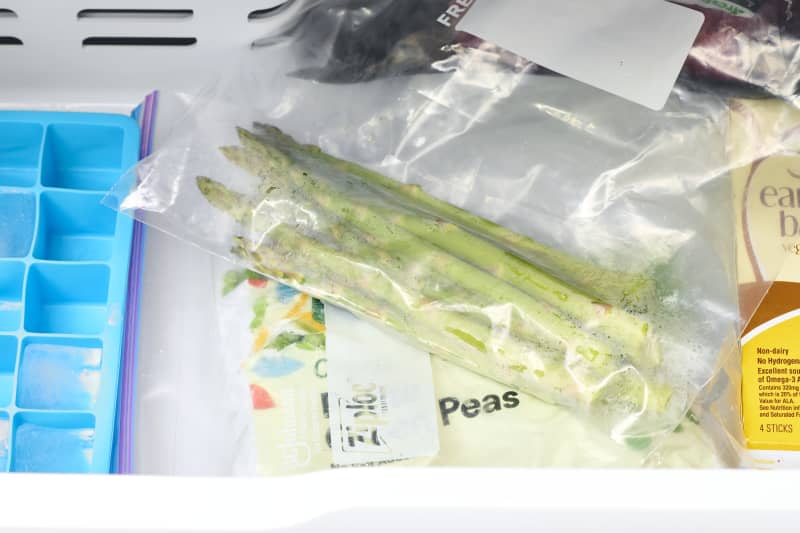
Asparagus Storage Method: Frozen in a Zip-top Freezer Bag
Stayed fresh for: 2 weeks, but …
Rating: 4/10
About this method: To test this technique, I placed the asparagus inside a gallon-sized zip-top freezer bag and removed as much air as possible. I mostly sealed the bag, inserted a straw into the small opening, and sucked out all the air; then I quickly removed the straw and sealed the bag. I placed the bag in the middle of my freezer and left it there for two weeks.
Results: The thing with this method is that it’s a prime example of a running joke I have that goes something like this: Basically all food freezes well, but how it thaws … that’s an entirely different story. And that’s the issue here. When the asparagus freezes, the water inside the cells crystallizes and punctures the walls of the cells. You can’t see that damage — the frozen spears look pristine and retain their lovely green color. But when you thaw the food (i.e., when I steamed it), the fluid leaks out from the cells, and the asparagus is limp, soggy, and mushy.

Asparagus Storage Method: At Room Temperature
Stayed fresh for: 5 days
Rating: 6/10
About this method: For this test, I placed the asparagus in a shallow bowl and moved it to a corner of the kitchen — on the countertop and out of direct sunlight.
Results: The asparagus looked pretty on the counter and lasted longer than I expected. I actually made a note that it would be gorgeous in a fruit-veggie produce centerpiece. But it didn’t last very long before it started showing signs of age. After three days, the tips began to look and feel a little dried out. And at five days, the stalks were wrinkled, some on the verge of withering. I hoped that steaming it might revive it to some degree, but no such luck. The cooked asparagus was discolored, some of it verging on brownish-olive, and it was simultaneously tough and limp.
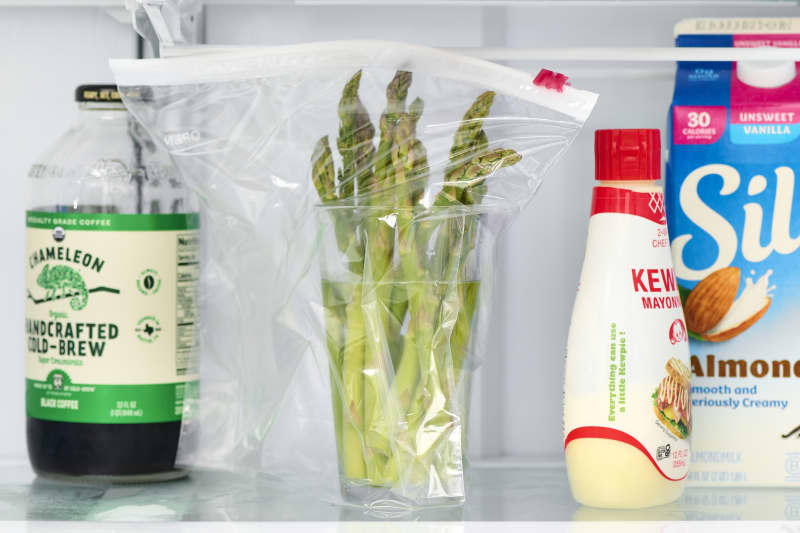
Asparagus Storage Method: Standing Upright in a Glass of Water with a Bag Placed over It
Stayed fresh for: 10 days
Rating: 6/10
About this method: For this technique, I stood the asparagus upright in a tall glass and added water to the bottom to a depth of an inch. I then placed a gallon-sized zip-top plastic bag over the glass and zipped it mostly closed. (The bag doesn’t completely enclose the glass; it’s more of a deep hood.) I placed this contraption on the top shelf of my fridge.
Results: There was no evaporation of the water from the bottom of the glass. The asparagus stalks were firm and unblemished, but the tips had started to become a bit slimy. I steamed this asparagus very briefly, and while the stalks were a lovely crisp-tender texture, the tips were a bit mushy.
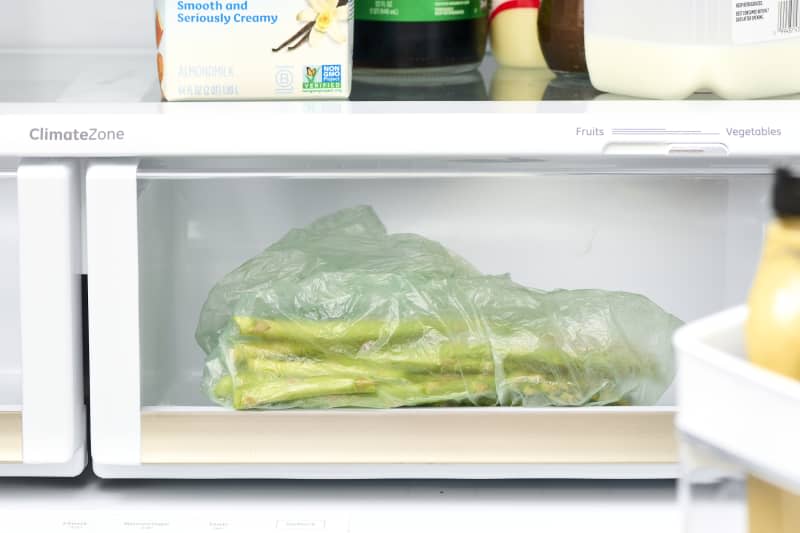
Asparagus Storage Method: In a Plastic Produce Bag in the Crisper
Stayed fresh for: 12 days
Rating: 7/10
About this method: I used the type of plastic bag you place your produce in at the grocery store, simply stashing the asparagus in it and placing it in the crisper drawer. I did not tie a knot in the bag; it remained unsealed.
Results: The asparagus held up well for almost two weeks. At the 12-day mark, the tips remained firm and tight, but the stalks were a bit withered and leathery-looking. Once steamed, the asparagus didn’t have the crisp-tender snap you expect from fresh spring stalks; it seemed a little soft.
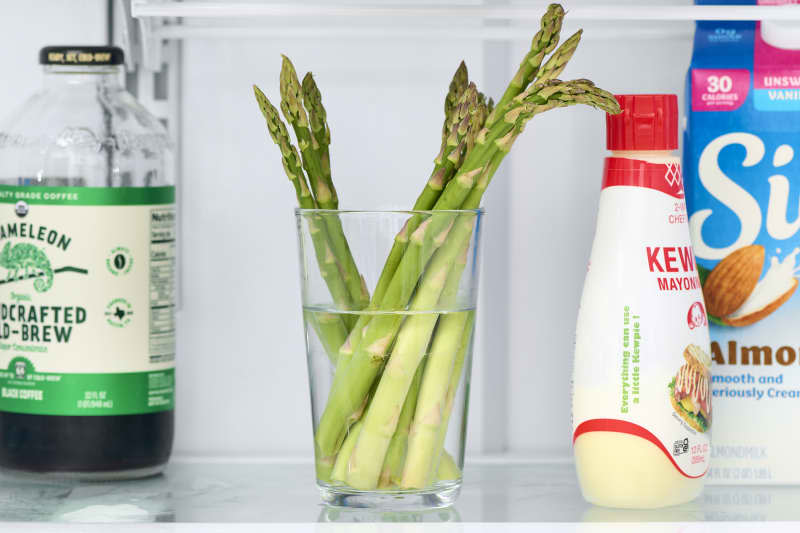
Asparagus Storage Method: Standing Upright in a Glass of Water Uncovered
Stayed fresh for: 14 days
Rating: 8/10
About this method: Similar to the other glass method above, I stood the asparagus upright in a tall glass and added water to the bottom to a depth of an inch — but I did not cover the asparagus in any way. I placed this glass on the top shelf of my refrigerator.
Results: All of the water evaporated by day eight, so I added just a bit more to keep the stems moist. Four days later, the asparagus was firm, and the stalks looked smooth and unblemished. The tips were just a bit dried out, feeling “crispy” when touched. When I steamed the asparagus, though, it was almost perfect, simply lacking a bit of the firm plumpness you get from very fresh stalks.
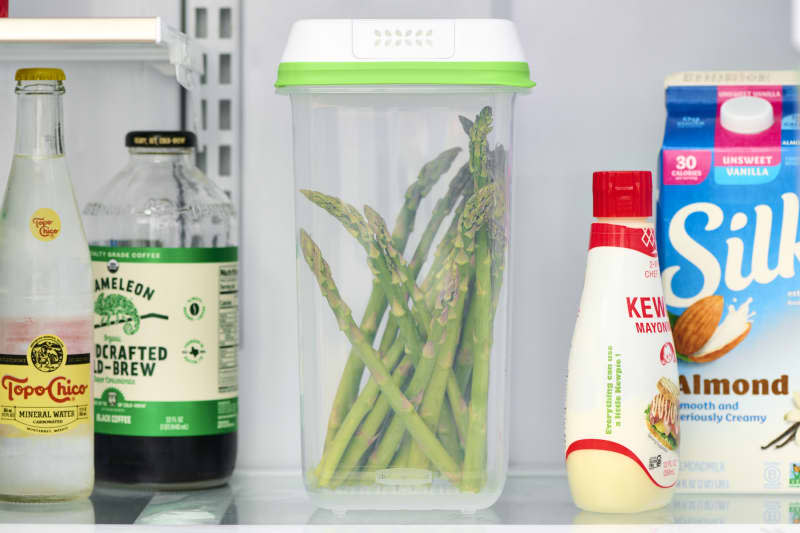
Asparagus Storage Method: In an Asparagus Storage Container
Stayed fresh for: 14 days
Rating: 9.5/10
About this method: I used a dedicated asparagus storage container for this test. I placed the asparagus inside, tips facing up, and stored the container on the top shelf of my refrigerator.
Results: When I reached in to take the asparagus out of the container, I felt condensation on all of the stalks. That concerned me at first, as I thought the asparagus might have developed soft or mushy spots from the moisture, but it was firm all over and appeared incredibly fresh. It basically seemed the same as it did the day I bought it. The cooked asparagus was delightful. The only reason this method did not receive a perfect rating is that it requires the purchase of a special container (and another low-cost method performed slightly better).
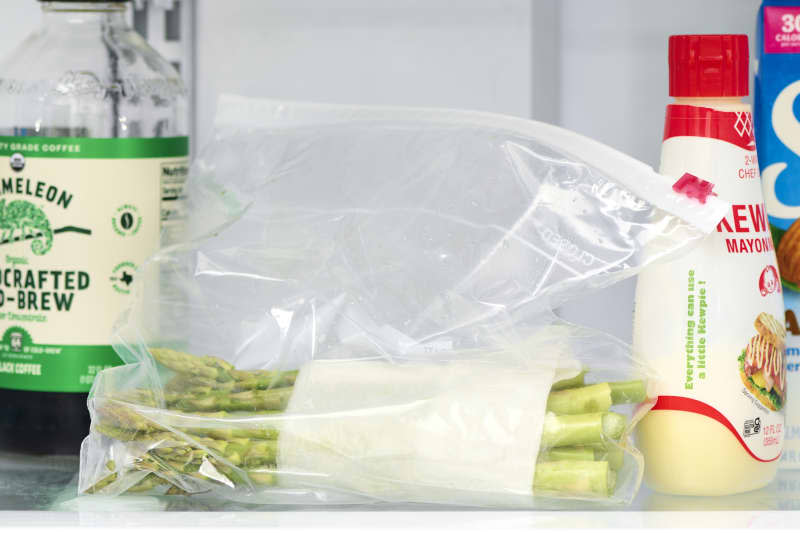
Asparagus Storage Method: Wrapped in Damp Paper Towels and Stored in a Zip-Top Bag
Stayed fresh for: 14 days
Rating: 10/10
About this method: For this test, I dampened a few paper towels (making sure to squeeze out most of the water so they weren’t wet), wrapped them around the asparagus, and then placed the paper towel-wrapped produce inside a gallon-size zip-top plastic bag. I then sealed the bag and stashed it on a middle shelf in my fridge.
Results: The asparagus was in excellent, positively pristine shape. All of the stalks were firm, with unblemished, taut stalks that looked identical to just-purchased asparagus. When I steamed this asparagus, it was the pinnacle of spring produce: perfectly crisp-tender, bright green, and glorious.
Overall Key Takeaways
If you’re going to use your asparagus within a few days, honestly all of the methods will work. But if you find asparagus on sale and choose to purchase a lot of it, or if you go overboard at the farmers market, there are a few methods here that will preserve your fresh finds for about two weeks.
If you buy asparagus regularly, a dedicated asparagus storage container will be a worthwhile investment, but take heart in knowing that a simple zip-top plastic bag and a few paper towels work just as well to keep your produce in tip-top condition for at least two weeks.

